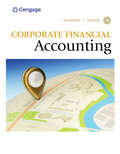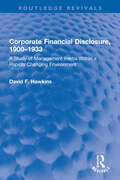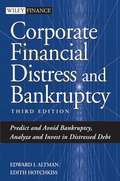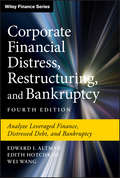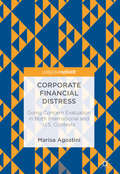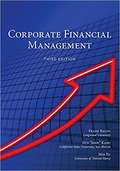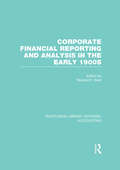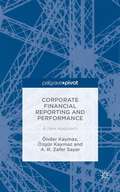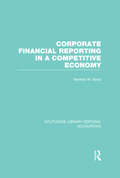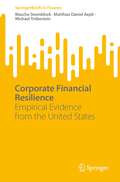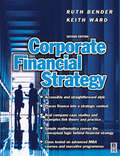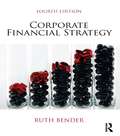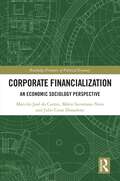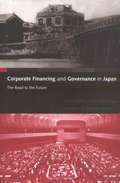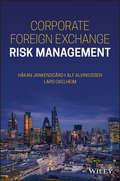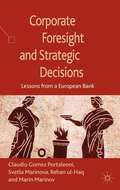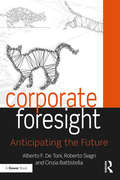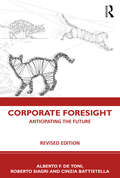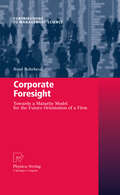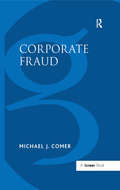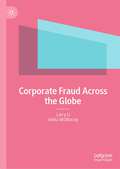- Table View
- List View
Corporate Financial Accounting (MindTap Course List)
by Carl S. Warren Jefferson P. JonesDiscover the importance of financial accounting in creating a successful business and prosperous society with Warren/Jones, CORPORATE FINANCIAL ACCOUNTING, 16E. This best-selling book clearly presents core financial accounting concepts within a meaningful business context, using engaging learning features that ensure a relevant, innovative learning experience. The authors demonstrate how accounting is more than just data or black-and-white rules. Updated content addresses the latest development and tools in corporate accounting today -- from using data analytics effectively to understanding the impact of discounts and sales in retail accounting. CNOWv2 online resources work with practice opportunities to ensure you understand and can apply key accounting principles. Prepare for immediate success on exams and advancements in your business career as you learn how to apply the key information that accounting provides to make critical business decisions.
Corporate Financial Disclosure, 1900-1933: A Study of Management Inertia Within a Rapidly Changing Environment (Routledge Revivals)
by David F. HawkinsThis book, first published in 1986, is a close analysis into management’s financial disclosure practices of the first half of the twentieth century. With criticisms of existing financial disclosure practices continuing to today, this study aims to make sense of the present through an examination of past practices, difficulties and solutions.
Corporate Financial Distress and Bankruptcy
by Edith Hotchkiss Edward I. AltmanA comprehensive look at the enormous growth and evolution of distressed debt, corporate bankruptcy, and credit risk defaultThis Third Edition of the most authoritative finance book on the topic updates and expands its discussion of corporate distress and bankruptcy, as well as the related markets dealing with high-yield and distressed debt, and offers state-of-the-art analysis and research on the costs of bankruptcy, credit default prediction, the post-emergence period performance of bankrupt firms, and more.
Corporate Financial Distress, Restructuring, and Bankruptcy: Analyze Leveraged Finance, Distressed Debt, and Bankruptcy (Wiley Finance)
by Wei Wang Edith Hotchkiss Edward I. AltmanA comprehensive look at the enormous growth and evolution of distressed debt markets, corporate bankruptcy, and credit risk models This Fourth Edition of the most authoritative finance book on the topic updates and expands its discussion of financial distress and bankruptcy, as well as the related topics dealing with leveraged finance, high-yield, and distressed debt markets. It offers state-of-the-art analysis and research on U.S. and international restructurings, applications of distress prediction models in financial and managerial markets, bankruptcy costs, restructuring outcomes, and more.
Corporate Financial Distress: A Study of the Italian Manufacturing Industry (SpringerBriefs in Finance)
by Matteo Pozzoli Francesco PaoloneThis book explores methods and techniques to predict and eventually prevent financial distress in corporations. It analyzes the effects of the global financial crisis on Italian manufacturing companies and, more specifically, whether the crisis has increased the number of firms that are likely to fail. In the first chapter, the authors widely discuss the Corporate Financial Distress as well as the process and costs incurred. The second chapter is based on a review of the most used statistical models, splitting them into accounting-based and market-based models. The following chapter is dedicated to the methodology and the empirical analysis on Italian manufacturing companies from different industries. The last chapter presents practical evidence from Italian manufacturing companies during the recent financial crisis.
Corporate Financial Distress: Going Concern Evaluation In Both International And U. S. Contexts
by Marisa AgostiniThis book, divided into three main parts, will offer a complete overview of the concept of corporate financial distress, emphasizing the different typologies of corporate paths included in this broad concept. It will reorganize and update academic literature about the evaluation of corporate financial distress from the first studies about failure prediction to the most recent contributions. It will also provide evidence about the evolution of going concern standards in both international and U.S. contexts. Moreover, an in-depth analysis of this broad concept will permit the identification of a set of research questions to be investigated from both theoretical and empirical points of view, and will be of interest to academic researchers and doctoral students of accounting, auditing and finance, professionals, and standard setters.
Corporate Financial Management
by Min Xu Frank Bacon Eun KangThe objective of Corporate Financial Management (Third Edition) is to introduce those principles essential to the understanding of financial problems, as well as policies that financial managers use to contend with those problems. To achieve this, the text stresses practical application in a user-friendly format. Corporate Financial Management is suitable for both undergraduate- and graduate-level core courses in finance, financial management and corporate finance. The text is written in a clear, concise and practical manner. <p><p> Readers will be exposed to all of the key tools and techniques of financial management and corporate finance without a complex treatment of theoretical financial concepts. The book includes twelve short cases designed to illustrate a series of real-life, current, and decision-oriented financial problems. The cases should enable students to strengthen their practical understanding of financial concepts and techniques. Without the added expense of a separate casebook, students can apply what that have learned in practical settings.
Corporate Financial Management: Options Exercises
by Timothy A. LuehrmanThis case presents four exercises designed to introduce students to applications of option pricing and decision-tree analysis to real corporate investment problems. Two of the four problems involve decision trees and two involve option pricing. Students should be familiar with basic option pricing theory (Black-Scholes and/or the Binomial Model) before being assigned these exercises.
Corporate Financial Reporting and Analysis in the early 1900s: Accounting: Corporate Financial Reporting And Analysis In The Early 1900s (Routledge Library Editions: Accounting)
by Richard P. BriefFirst published in 2014. Routledge is an imprint of Taylor & Francis, an informa company.
Corporate Financial Reporting and Performance: A New Approach
by Önder Kaymaz Özgür Kaymaz A. R. Zafer SayarGlobalization and the accompanying investment facilities available have resulted in rapid popularity for international financial reporting standards (IFRS). However, differences often exist in terms of what firms report, and once inconsistency between tax regulations and financial reporting regulations occur, differences between taxable and accounting practices are inevitable. This book introduces a new approach to corporate financial reporting by investigating goal incongruence (GING) in the context of the principal and agent (PA) setting. The authors argue that improving the method for the disclosure of information would not only increase the quality of corporate financial information and reporting but also reduce the possibility of any GING arising. This book presents the financial implications of international accounting and financial reporting standards (IAS and IFRS), presenting numerous real-life situations, cases, examples and implications to reveal how GING might influence the implementation of corporate financial reporting of profit volumes and sizes, which are the leading drivers of and widely accepted proxies for corporate financial performance.
Corporate Financial Reporting in a Competitive Economy (Routledge Library Editions: Accounting)
by Herman W. BevisThis book is concerned with the financial accounting and reporting of publicly owned corporations to their shareholders. It examines the origins of financial accounting and reporting, external influences on accounting and reporting practices as well as the measurement process.
Corporate Financial Reporting: Theory and Practice
by Dr Andrew W Higson`This is a book which should be read by all students, whether undergraduate and postgraduate. It also provides a succinct guide for the manager who wishes to come to grips with this topic, or the accountant nostalgic to recollect the non too praiseworthy and indecisive history of this topic' - Managerial Auditing Journal Corporate Financial Reporting critically examines contemporary corporate financial reporting. The complexity of the reporting process and the myriad of issues facing the directors, accountants and auditors can only be successfully understood from a firm conceptual base. Recent financial scandals clearly highlight the interrelationships between all the themes explored in this book, from financial reporting to auditing, from management's motivations to fraud. Special features of this book include: - A critical examination of accounting 'theory' - Senior practitioners' insights on 'a true and fair view' - An exploration of 'the financial reporting expectations gap' - A discussion of the nature of 'corporate performance' - An examination of corporate fraud - An examination of the implications of 'real-time' reporting by companies - Discussion questions at the end of each chapter The book will be relevant to advanced undergraduate as well as postgraduate and MBA students.
Corporate Financial Resilience: Empirical Evidence from the United States (SpringerBriefs in Finance)
by Michael Trübestein Matthias Daniel Aepli Mascha SteenblockThis research presents a rigorous investigation of US companies' financial resilience within the S&P 500 index from the year 2000 onward. The book focuses on the process of a company's bounce back to pre-crisis levels after a disturbance, exploring resilience measured through recovery duration and various financial performance indicators. The study analyzes three significant crises faced by the US during this period - the dotcom crisis, the global financial crisis, and the pandemic crisis. Through applied cox hazard regression and panel regression, the book reveals valuable empirical insights on factors impacting corporate financial resilience, sector-specific crisis effects, and essential considerations when interpreting the results. Investors, corporations, and researchers alike will find this data-driven resource a paramount asset in navigating the complexities of financial markets and fortifying corporate financial resilience for a prosperous future.
Corporate Financial Strategy
by Keith Ward Ruth BenderCorporate Financial Strategy is a practical guide to understanding the elements of financial strategy, and how directors and advisors can add value by tailoring financial strategy to complement corporate strategy.The book sets out appropriate financial strategies over the key milestones in a company's life. It discusses the practicalities behind transactions such as:* Raising venture capital* Flotation on a stock exchange* Making acquisitions* Management buyouts* Financial restructuringIn explaining financing structures, the book sets out the basic building blocks of any financial instrument to enable the reader to appreciate innovations in the field. It also illustrates how and why different types of security might be used.The second edition of this very popular textbook brings to bear the considerable commercial and academic experience of its co-authors. Throughout, the book offers a range of up-to-date case studies, abundant diagrams and figures, and frequent 'Working Insight' sections to provide practical illumination of the theory.This book will enable you to understand the potential value added by the best financial strategy, while fully demonstrating the working role of financial strategy within an overall corporate strategy. An excellent practical guide for senior financial managers, strategic-decision makers and qualified accountants, the text is also invaluable as a clear-sighted and thorough companion for students and senior executives on finance courses (including MBA, MSc and DMS).
Corporate Financial Strategy
by Ruth BenderThe field of Corporate Finance has developed into a fairly complex one from its origins focussed on a company's business and financial needs (financing, risk management, capitalization and budgeting). Corporate Financial Strategy provides a critical introduction to the field and in doing so shows how organizations' financial strategies can be aligned with their overall business strategies. Retaining the popular fundamentals of previous editions, the new edition brings things up to date with an array of new examples and cases, new pedagogical features such as learning objectives and suggested further reading, and includes new material on mergers and acquisitions, and valuations and forecasting. Unlike other textbooks, Ruth Bender writes from the perspective of the firm rather than the investor. Combined with a structure driven by issues, the result is a textbook which is perfectly suited to those studying corporate finance and financial strategy at advanced undergraduate, postgraduate and executive education levels.
Corporate Financialization: An Economic Sociology Perspective (Routledge Frontiers of Political Economy)
by Marcelo José do Carmo Julio Cesar Donadone Mário Sacomano NetoThe economic process of financialization is defined by many as the development of the dependence and subordination of the productive sector to the financial sector. Leading to an emphasis on maximizing shareholder value above all else, the financialization of the economy and production has an enormous impact on the everyday life of ordinary people including the erosion of employment right, the rise of precarious work, and rising inequalities. Using multicase study research and an exploratory approach, this book analyzes the financialization process in the ten companies with the highest market capitalization worldwide including tech firms, oil companies and banks. This book analyzes indicators of financialization in large corporations including a comparison between profitability sources; shareholding structure, acquisitions and sales of shares; mergers and acquisitions; the origins of directors; payment of compensation to executives; dividend payments to shareholders and stock repurchases; employee salaries; and employment levels. The data demonstrates that what would once have been considered non-core business activities have become more profitable than core business activities in many of these companies. In some cases, these companies are responsible for large investment funds and financial-type institutions which already surpass the largest banks in terms of assets under management. Meanwhile, the average salaries at some of these companies have been falling in real terms due to the rise of outsourcing and the use of cheap or precarious labour. Adopting an economic sociology approach, this book marks a significant contribution to the literature on financialization in economics, sociology and business.
Corporate Financing and Governance in Japan: The Road to the Future
by Takeo Hoshi Anil Kashyap Stanley Fischer45th Nikkei Prize for Excellent Books in Economic Science, presented by the Japan Center for Economic Research and Nihon Keizai Shimbun Inc. on November 5, 2002. In this book Takeo Hoshi and Anil Kashyap examine the history of the Japanese financial system, from its nineteenth-century beginnings through the collapse of the 1990s that concluded with sweeping reforms. Combining financial theory with new data and original case studies, they show why the Japanese financial system developed as it did and how its history affects its ongoing evolution. The authors describe four major periods within Japan's financial history and speculate on the fifth, into which Japan is now moving. Throughout, they focus on four questions: How do households hold their savings? How is business financing provided? What range of services do banks provide? And what is the nature and extent of bank involvement in the management of firms? The answers provide a framework for analyzing the history of the past 150 years, as well as implications of the just-completed reforms known as the "Japanese Big Bang. " Hoshi and Kashyap show that the largely successful era of bank dominance in postwar Japan is over, largely because deregulation has exposed the banks to competition from capital markets and foreign competitors. The banks are destined to shrink as households change their savings patterns and their customers continue to migrate to new funding sources. Securities markets are set to re-emerge as central to corporate finance and governance.
Corporate Foreign Exchange Risk Management
by Lars Oxelheim Alf Alviniussen Håkan JankensgårdA practical and accessible guide that demystifies ForEx risk for managers in all areas of business Virtually any organisation active in the global economy is impacted by fluctuations in foreign exchange (FX or ForEx) markets. Managers need to understand this increasingly complex issue and measure their firm’s exposure to risk. Corporate Foreign Exchange Risk Management is an in-depth yet accessible guide on effective ForEx exposure management. Designed for professionals responsible for managing a profit & loss or balance sheet influenced by ForEx fluctuations, it enables risk managers to navigate the interconnected worlds of financial management and economics. This innovative guide integrates academic discussion of the economics of risk management decisions and pragmatic advice for various situations in which performance measures affected by accounting standards are paid considerable attention. Readers are provided with the tools and knowledge required to handle a broad range of issues related to ForEx risk management. Clear, non-technical chapters demystify concepts that often appear complicated and confusing to managers. Written by globally-recognised experts in corporate finance, risk management and international business, this book: Employs a reader-friendly narrative style to explain complex concepts Provides a clear, actionable risk management strategy which can be used in a variety of businesses Places all concepts in relatable, real-world contexts Explains important academic research to practitioners in plain English Includes effective pedagogical tools and explanations, straightforward examples and end-of-chapter summaries which highlight key points Corporate Foreign Exchange Risk Management is a must-read for any manager who deals with corporate exposure to ForEx risk, as well as analysts wishing to better understand the relation between corporate performance and ForEx fluctuations and students of corporate risk management.
Corporate Foresight and Strategic Decisions
by Svetla Marinova Marin Marinov Claudio Gomez Portaleoni Rehan Ul-HaqThis study investigates the relationships between corporate foresight and management decision-making processes in organizations. It provides an extensive analysis of extant theories of corporate foresight and strategic management, brings in new insights, and presents an in-depth case study exploration of corporate foresight of a European bank.
Corporate Foresight: Anticipating the Future
by Alberto F. De Toni Roberto Siagri Cinzia BattistellaThis book illustrates how to anticipate the future using more than the traditional predictive models (forecasting) based on the forward projection of past experiences, and moving into more advanced methods of anticipation logic (foresight) to build probable scenarios based on weak signals, emerging trends, coexisting presents and potential paths of evolution. Utilizing a helpful, four-part structure, the authors indicate how corporate foresight is fundamental to interpret and lead change, focusing on the two cornerstones of organization and management. They advocate the separation of Research (oriented to the market of tomorrow) from Development (oriented to the market of today), the establishment of a Foresight unit and the concentration of research activities mainly on the acquisition and recombination of external know-how. After an overview of state-of-the-art literature on forecasting methods, they further propose the implementation of a "future coverage" methodology, which will enable companies to measure and verify the consistency between trends, strategic vision and offered products. These organizational and managing tools are then tested in a case study: the Italian company Eurotech SpA, a leader in the ICT sector. A useful resource for both managers and researchers, the book will help readers gain the tools necessary to tackle change and navigate complexity in organizations.
Corporate Foresight: Anticipating the Future
by Alberto F. De Toni Roberto Siagri Cinzia BattistellaThe world changes like the patterns in a kaleidoscope: trends expand, contract, break up, melt, disintegrate and disappear, while others are formed. Change – as opposed to stasis - is our normal condition, the only certainty in our lives. Hence the need to create tools that provide organizations with the means to tackle change and navigate complexity. We must accept the reality of constant change and be prepared to a heavy shift in perspective: interconnection versus separation, acceleration versus linearity, discontinuity versus continuity. Anticipating the future requires more than the traditional predictive models (forecasting) based on the forward projection of past experiences. Advanced methods use anticipation logic (foresight) and build probable scenarios taking into account weak signals, emerging trends, coexisting presents and potential paths of evolution. Corporate foresight is fundamental to interpret and lead change. The two cornerstones of foresight are organization and management. As concerns organization, the authors advocate the separation of Research (oriented to the market of tomorrow) from Development (oriented to the market of today), the establishment of a Foresight unit and the concentration of research activities mainly on the acquisition and recombination of external know-how. As regards management, after an overview of state-of-the-art literature on forecasting methods, the authors propose the implementation of a "future coverage" methodology, which enables companies to measure and verify the consistency between trends, strategic vision and offered products. These organizational and managing tools are then tested in a case study: the Italian company Eurotech SpA, a leader in the ICT sector.
Corporate Foresight: Towards a Maturity Model for the Future Orientation of a Firm (Contributions to Management Science)
by René RohrbeckHave you ever wondered why even large companies fail when faced with changes in their environment? Would you be surprised to learn that the average life expectancy of a Fortune 500 company is below 50 years? This book presents findings from 19 case studies in multinational companies such as Siemens, Volkwagen, General Electric, Philips and Deutsche Telekom. René Rohrbeck proposes a Maturity Model to assess how prepared a company is to respond to external (disruptive) change. He uses data from 107 interviews with board members, corporate strategists, innovation managers, and corporate foresight professionals to present and discuss best practices. Using illustrations to show the complex interaction of corporate foresight with other units such as innovation and strategic management, René Rohrbeck provides the reader with rich insights on how to make an organization agile and reactive towards change. For scholars this book proposes multiple hypotheses and frameworks for future research.
Corporate Fraud
by Michael J. ComerFact: Barings was an excellent company, with professional managers. Their careers were devastated by fraud. How many other managers are now in the same position without knowing it? Fact: The average company loses between 2 per cent and 5 per cent of its turnover as a result of dishonesty. When Mike Comer’s book first appeared it quickly established itself worldwide as the standard work in its field. This third edition is a radical revision reflecting the world of EDI, electronic commerce, derivatives, computerization, empowerment, downsizing and other recent developments. Ironically, many of these have exposed companies to an alarming range of new risks. With the help of real-life case histories the author identifies the main types of fraud, the circumstances in which they occur and the telltale signs that give them away. He examines internal control systems and the attitudes and practices that allow fraud to flourish. He explains in detail how fraud can be prevented and detected, and shows why it is that many fashionable management techniques can also potentially pave the way to corporate disaster.
Corporate Fraud Across the Globe
by Adela McMurray Larry LiBased on theoretical foundations and evidence-based case studies, this book identifies the fundamental motivations underpinning corporate fraud in both developing and developed countries. The book offers practical solutions in terms of monitoring and potentially preventing future corporate fraud activity. It is expected that uncovered corporate fraud negatively affects the public reputation, and financial performance of fraudulent firms. However, what is of more importance for fraudulent firms is how to regain the trust of customers, investors, and other stakeholders, as this impacts the long-term sustainability of businesses. Operational strategies, including reform, provide an effective channel for a fraudulent firm’s business sustainability yet this notion remains unexplored in the literature. This authored research book argues that the choice of appropriate operational strategies is critical as they serve as an effective channel for fraudulent firms to re-gain the trust from customers and markets, re-establish their reputation, and enhance the firm’s long-term value. The authors posit that there is no ‘one-size fits-all’ approach because the choice of effective operational strategies is needed to acknowledge the significance of context such as industry type, economic conditions, legal frameworks as well as the firm’s fraudulent characteristics.
Corporate Fraud Handbook: Prevention and Detection
by Joseph T. WellsDelve into the mind of a fraudster to beat them at their own game Corporate Fraud Handbook details the many forms of fraud to help you identify red flags and prevent fraud before it occurs. Written by the founder and chairman of the Association of Certified Fraud Examiners (ACFE), this book provides indispensable guidance for auditors, examiners, managers, and criminal investigators: from asset misappropriation, to corruption, to financial statement fraud, the most common schemes are dissected to show you where to look and what to look for. This new fifth edition includes the all-new statistics from the ACFE 2016 Report to the Nations on Occupational Fraud and Abuse, providing a current look at the impact of and trends in fraud. Real-world case studies submitted to the ACFE by actual fraud examiners show how different scenarios play out in practice, to help you build an effective anti-fraud program within your own organization. This systematic examination into the mind of a fraudster is backed by practical guidance for before, during, and after fraud has been committed; you'll learn how to stop various schemes in their tracks, where to find evidence, and how to quantify financial losses after the fact. Fraud continues to be a serious problem for businesses and government agencies, and can manifest in myriad ways. This book walks you through detection, prevention, and aftermath to help you shore up your defenses and effectively manage fraud risk. Understand the most common fraud schemes and identify red flags Learn from illustrative case studies submitted by anti-fraud professionals Ensure compliance with Sarbanes-Oxley and other regulations Develop and implement effective anti-fraud measures at multiple levels Fraud can be committed by anyone at any level—employees, managers, owners, and executives—and no organization is immune. Anti-fraud regulations are continually evolving, but the magnitude of fraud's impact has yet to be fully realized. Corporate Fraud Handbook provides exceptional coverage of schemes and effective defense to help you keep your organization secure.
